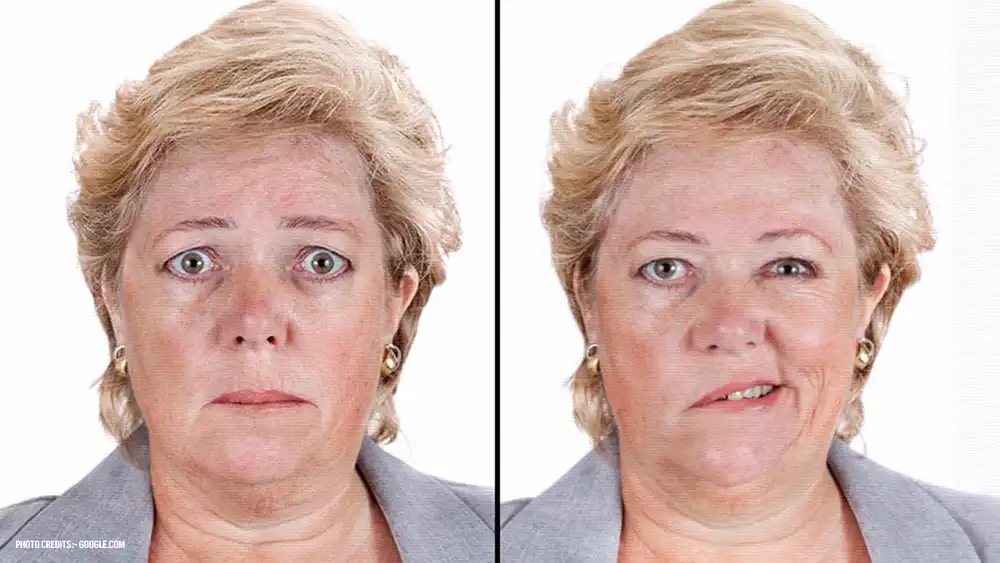
NEUROSCIENCE
A Case Study Exploration of Prosopometamorphopsia (PMO): The Complexities of Facial Distortions
-
 Rahul Priydarss
Rahul Priydarss - June 7, 2024
Explore the in-depth case studies of Michael Thompson and Sarah Jones, revealing the complexities of diagnosing and treating prosopometamorphopsia (PMO). Learn how personalized treatment plans, including medication, lifestyle changes, and therapy, can significantly improve the quality of life for individuals suffering from PMO and migraines. Discover the importance of a multidisciplinary approach and the need for continued research in understanding and managing this rare condition.
What is Prosopometamorphopsia:
Prosopometamorphopsia (PMO) is a rare visual disorder characterized by the distorted perception of facial features. Individuals with PMO may experience abnormal and fluctuating perceptions of faces, including distortions in size, shape, and appearance. This condition can cause faces to appear elongated, shrunken, or morphed in various ways, making it difficult to recognize familiar faces accurately. PMO can significantly impact daily life and social interactions, leading to feelings of distress and social isolation.
Types of Prosopometamorphopsia:
Prosopometamorphopsia (PMO) can manifest in different ways, leading to various types of the condition. The types of PMO include:
Generalized Prosopometamorphopsia: In this type, individuals experience distortions in the appearance of all faces, including those of familiar and unfamiliar individuals.
Partially Selective Prosopometamorphopsia: This type involves distortions in the perception of specific types of faces or specific facial features while other faces remain relatively unaffected.
Unilateral Prosopometamorphopsia: Unilateral PMO affects only one side of the visual field, resulting in distortions in the perception of faces presented on that side.
Bilateral Prosopometamorphopsia: In contrast to unilateral PMO, bilateral PMO affects both sides of the visual field, leading to distortions in the perception of faces presented on either side.
Static Prosopometamorphopsia: Static PMO involves persistent distortions in the appearance of faces, which remain relatively stable over time.
Dynamic Prosopometamorphopsia: Dynamic PMO is characterized by fluctuating distortions in the perception of faces, with the appearance of facial features changing dynamically over time.

Table of Contents
Case Study 1: Michael Thompson and the Mystery of Distorted Faces:
Initial Presentation: Michael Thompson, a 28-year-old graphic designer, walked into the neurologist’s office troubled by a two-year struggle with distorted faces. He described faces stretching unnaturally long, eyes shrinking, and mouths twisting into unsettling frowns. These distortions were unpredictable, lasting anywhere from minutes to a full hour. Alongside these visual distortions, Michael also experienced flashing lights and zigzagging patterns about 30 minutes before the facial distortions hit.
Medical History: Michael’s medical history revealed a diagnosed case of migraines with aura since his teenage years. He experienced migraine headaches roughly once a month, each preceded by a visual aura. Despite this, he wasn’t taking any regular medication for his migraines. This background of migraines, combined with the specific visual disturbances, provided the neurologist with critical clues to understanding his current condition.
Neurological Examination and Initial Diagnosis: A thorough neurological examination did not show any abnormalities. However, the neurologist suspected a connection between Michael’s migraines with aura and his distorted face. The combination of facial distortions and visual aura often suggests a link to migraine activity in the brain. To rule out other potential causes, an MRI scan was conducted.
Diagnostic Imaging: The MRI scan was normal, showing no structural brain abnormalities such as tumors or lesions. This further reinforced the neurologist’s hypothesis that Michael’s symptoms were related to his migraines rather than a structural brain issue. Based on Michael’s symptoms, particularly the co-occurrence of visual aura and facial distortions, a diagnosis of Prosopometamorphopsia (PMO) associated with migraines was made.
Treatment Plan:
Pharmacological Intervention: To address the underlying migraines and hopefully reduce the frequency and severity of both migraines and the associated PMO episodes, a daily medication specifically designed to prevent migraines was prescribed. This medication aimed to regulate brain activity and provide a more stable neurological environment.
Lifestyle Modifications: The neurologist also discussed lifestyle modifications with Michael. Factors such as stress, lack of sleep, and dietary triggers can exacerbate migraines. They worked on strategies for managing stress, maintaining a regular sleep schedule, and identifying and avoiding potential dietary triggers. These modifications were essential components of his comprehensive treatment plan.
Treatment Outcomes:
Initial Phase: Within a month, Michael reported significant improvements. The migraine preventative medication effectively reduced the frequency of both migraines and PMO episodes. He experienced fewer visual auras and a noticeable decrease in the duration and severity of facial distortions.
Continued Progress: Over the next few months, this positive trend continued. Michael’s migraines became less frequent and intense, and the PMO episodes became even rarer. By the six-month mark, Michael reported a dramatic improvement in his quality of life. The migraines and PMO episodes were infrequent and manageable, and he felt a greater sense of control over his condition.
Medication and Treatment for Michael Thompson:
Case Study 1: Michael Thompson: Michael Thompson, a 28-year-old graphic designer, began his treatment plan with a focus on preventing migraines, which were linked to his facial distortions. His neurologist prescribed Topiramate (Topamax), a medication commonly used to prevent migraines. Michael started on a low dose of 25 mg per day, gradually increasing to 100 mg per day over several weeks, depending on his tolerance and the effectiveness of the medication. To address acute migraine attacks, he was prescribed Sumatriptan (Imitrex). Michael took 50 mg tablets at the onset of a migraine or visual aura, with the option to take an additional 50 mg after two hours if needed, not exceeding 200 mg in 24 hours. For pain management during severe migraine episodes, Michael was advised to take 800 mg of Ibuprofen as needed, up to three times a day.
In addition to medication, Michael’s treatment included significant lifestyle modifications. Stress management techniques, such as mindfulness meditation, regular exercise, and adequate rest, were recommended. Dietary adjustments were also crucial, with Michael avoiding known migraine triggers such as caffeine, alcohol, and certain foods like chocolate and aged cheeses. Maintaining a consistent sleep schedule and ensuring 7-8 hours of sleep per night were emphasized to support his overall health.
Michael’s progress was closely monitored through monthly follow-ups for the first six months. The dosage of Topiramate was adjusted based on his response and any side effects he experienced. If necessary, the neurologist considered adding Amitriptyline (Elavil) at a low dose (10-25 mg at bedtime) for its dual benefits on migraines and sleep improvement. Over time, Michael continued taking Topiramate long-term, as it significantly reduced his migraine frequency and Prosopometamorphopsia (PMO) episodes. For acute migraine management, he continued using Sumatriptan as needed. Regular bi-annual reviews were scheduled to reassess the effectiveness of the treatment and manage any side effects.

Case Study 2: Sarah Jones and the Battle Against Distorted Faces:
Initial Presentation: Sarah Jones, a 42-year-old accountant, entered the neurology clinic with a tremor in her voice and worry etched on her face. For the past six months, she’d been plagued by a terrifying phenomenon – faces, both familiar and those of strangers, would morph and distort before her eyes. Describing it as a funhouse mirror come to life, Sarah explained how eyes would bulge grotesquely, noses contort into cartoonish hooks, and mouths stretch into unsettling grins. The constant visual distortions made daily life a challenge, leaving her barely able to recognize the people around her.
Medical History and Neurological Examination: Despite a clean bill of health with no history of migraines, epilepsy, or head injuries, a thorough neurological exam by the specialist revealed no abnormalities. However, Sarah’s vivid description of the distorted faces resonated with a rare condition – prosopometamorphopsia (PMO). Given the rarity of PMO, further investigation was necessary.
Diagnostic Imaging and Tests:
MRI Scan: An MRI scan aimed to rule out any structural abnormalities in the brain that might explain the bizarre visual disturbances. Thankfully, the scan came back clean, showing no signs of tumors, strokes, or any other lesions that could be causing the distortions.
Visual Evoked Potentials (VEPs): To delve deeper, visual evoked potentials (VEPs) were employed. This test measures the electrical activity of the brain in response to visual stimuli. While the VEP results weren’t conclusive, they didn’t contradict the possibility of PMO. Armed with the information from Sarah’s experience, the absence of alternative explanations, and the normal brain scans, the neurologist confidently diagnosed Sarah with PMO.
Treatment Plan:
Pharmacological Intervention: Crafting a treatment plan for Sarah required a multi-pronged approach. Although Sarah hadn’t reported a history of migraines, some PMO cases have been linked to migraines without aura. As a preventative measure, a low-dose daily medication typically used to prevent migraines was prescribed. The hope was that regulating brain activity in this way might offer some relief from the visual distortions.
Vision Therapy: Sarah was referred to a vision therapist with expertise in retraining the brain’s visual processing pathways. Through specifically designed exercises, the therapy aimed to improve Sarah’s visual perception and reduce the distressing distortions.
Psychological Support: Recognizing the emotional toll PMO can take, the neurologist also recommended psychological support. Therapy sessions focused on equipping Sarah with tools to manage the anxiety and social isolation that often accompany PMO.
Treatment Outcomes:
Initial Phase: The journey to manage PMO wasn’t a straight line for Sarah. The initial month brought minimal improvement. The facial distortions persisted, although the migraine medication did offer a glimmer of hope by reducing the frequency of the episodes.
Continued Progress: With consistent effort in visual therapy, positive results began to emerge by the third month. Sarah reported a slight decrease in the severity of the warping and a newfound ability to mentally reconstruct faces to their normal appearance, offering a sense of control over the distortions.
Long-Term Improvement: By the six-month mark, the impact of PMO on Sarah’s life had lessened considerably. The therapy sessions had equipped her with strategies to manage the anxiety, and the distortions themselves had become less pronounced and less frequent. While some distortions remained, they were no longer overwhelming, and Sarah could usually recognize familiar faces.
Medication and Treatment for Sarah Jones:
Case Study 2: Sarah Jones: Sarah Jones, a 42-year-old accountant, began her treatment with Propranolol (Inderal), a beta-blocker commonly used to prevent migraines. She started on 20 mg twice daily, with the dose adjusted up to 80 mg twice daily based on her response and tolerance. Alongside medication, Sarah was referred to a vision therapist who provided her with exercises designed to retrain her brain’s visual processing pathways, aiming to reduce the severity and frequency of her visual distortions.
Recognizing the emotional toll of her condition, Sarah’s treatment also included psychological support. She was referred to a psychologist for Cognitive Behavioral Therapy (CBT) to help manage the anxiety and stress associated with her PMO. Lifestyle modifications were another critical aspect of her treatment. Sarah implemented stress-reducing techniques like yoga, deep breathing exercises, and regular physical activity. She also worked on identifying and avoiding potential dietary triggers and maintaining a regular sleep schedule.
Sarah’s initial progress was slow, with minimal improvement in the first month. However, consistent effort in vision therapy and regular psychological support sessions began to show positive results by the third month. Sarah attended bi-weekly vision therapy sessions for the first three months, adjusting her exercise regimen as needed. Monthly sessions with a psychologist helped monitor and support her mental health. Based on her response, the dosage of Propranolol was adjusted. If Propranolol proved ineffective or poorly tolerated, alternatives like Amitriptyline or Topiramate were considered.
Long-term, Sarah continued taking Propranolol if it effectively managed her symptoms. She reduced her vision therapy sessions to monthly or as needed and maintained ongoing CBT sessions to help manage any residual anxiety. Regular bi-annual follow-ups with her neurologist ensured that her condition was continually reassessed, and her treatment remained effective.
Overall Implications and Future Directions:
The Michael Thompson and Sarah Jones cases underscore the complexity and variability of PMO and its management. While Michael’s PMO was closely linked to his migraines with aura, Sarah’s condition presented without a clear migraine history, requiring a broader diagnostic and therapeutic approach. These cases highlight several key implications for clinical practice and research:
Individualized Treatment Approaches: Tailoring treatment plans to the individual’s specific symptoms and medical history is crucial. For Michael, migraine prevention was the key, while for Sarah, a combination of migraine prevention, vision therapy, and psychological support proved effective.
Comprehensive Diagnostic Evaluation: A thorough diagnostic workup, including imaging and specialized tests like VEPs, is essential to rule out other causes and confirm the diagnosis of PMO.
Importance of Lifestyle Modifications: Addressing lifestyle factors that can exacerbate symptoms, such as stress and sleep patterns, is critical in managing PMO effectively.
Need for Further Research: Continued research is needed to better understand the pathophysiology of PMO, its connection to migraines, and the most effective treatment strategies.
FAQs about Prosopometamorphopsia:
A1: Prosopometamorphopsia (PMO) is a rare condition characterized by the distortion of facial features, causing faces to appear unnaturally altered or grotesque.
A2: Michael’s PMO was treated primarily by addressing his underlying migraines with Topiramate and Sumatriptan, alongside lifestyle modifications to manage stress, sleep, and dietary triggers.
A3: Sarah’s treatment included Propranolol for migraine prevention, vision therapy to retrain her brain’s visual processing pathways and Cognitive Behavioral Therapy (CBT) for managing anxiety.
A4: Lifestyle modifications, such as stress management, maintaining a regular sleep schedule, and avoiding dietary triggers, are crucial as they can help reduce the frequency and severity of both migraines and PMO episodes.
A5: The cases of Michael and Sarah suggest that a personalized, comprehensive treatment approach, which may include medication, therapy, and lifestyle changes, can lead to significant improvement in managing PMO symptoms.
-Please remember, to always consult with healthcare professionals or Doctors for personalized advice related to medical conditions.
Conclusion:
Michael Thompson and Sarah Jones’ cases underscore the complexity of diagnosing and treating prosopometamorphopsia (PMO). Michael’s migraine-focused treatment significantly reduced his PMO symptoms, while Sarah’s comprehensive approach, including vision therapy and psychological support, led to marked improvement. These cases highlight the importance of personalized, multidisciplinary treatment plans and the need for further research to better understand PMO. Effective management of PMO involves addressing underlying conditions and lifestyle factors. Ultimately, tailored treatments can greatly enhance patients’ quality of life.




